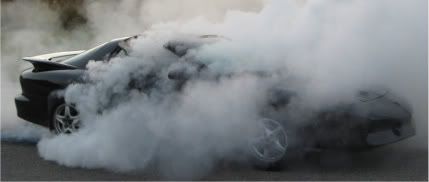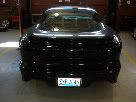Myth 3: I Need A Little Bit of Backpressure For Midrange Power
THE MIGHTY BACKPRESSURE MYTH:
You want zero backpressure not some backpressure as you may sometimes hear from a salesman or an old timer V8 hot rodder.
Stock backpressure is around 16 psi in a GSR. Good aftermarket exhausts yield 2-5 psi backpressure. "Bolt-ons only" engine packages, in the past, used exhausts with some backpressure, since there is this incorrect belief that having a little backpressure prevents the fresh air/fuel from shooting into the header at cam overlap (when both the opening intake valve & the closing exhaust valve are simultaneously, partially open). The backpressure supposedly "pushed" the fresh air/fuel back into the combustion chamber rather than having it go into the header. This shooting of fresh air/fuel from the intake manifold and intake port into the header cannot happen at cam overlap, since the pressure inside the header is already much higher than on the intake side , even when there is zero backpressure.
In reality, having more backpressure reduces the difference between the higher pressure in the head's exhaust port and lower pressure in the header and cat. You need this difference in pressure going from the head to the exhaust system or "pressure gradient" to keep the exhaust flow speed or energy at a high level. Having some backpressure during cam overlap and the exhaust stroke means that the exhaust gas must now push against something and therefore, this backwards force slows exhaust gas down.
This need for backpressure no longer exists when you have a properly tuned (timed) engine and a good stepped header. In fact, increased backpressure may lead to backwards flow or "reversion", where the exhaust gas travels backwards into the combustion chamber and dilutes the fresh intake charge at cam overlap. At the very least, it slows exhaust flow velocity or energy and prevents the creation of a vacuum for scavenging.
So please ignore the obsolete "you should have at least some backpressure" sales pitch. It's all about the creating high exhaust flow velocity/speed or energy leaving the exhaust port, in order for the header-cat-exhaust SYSTEM to do it's job properly (i.e. remove all the burnt exhaust gases and help pull in fresh intake charge by scavenging at cam overlap) and make power for you.
Regarding the backpressure issue:
Many people use backpressure to get midrange driveability at the sacrifice of lower power potential at the upper powerband rpms. Using back pressure is the wrong way to build a high performance exhaust system. The exhaust system should extract the exhaust from the header, to minimize parasitic pumping pressures.
The proper way to make an exhaust system that will act as an extractor is to properly size the tubing so that the the exhaust gas' flow velocity creates a "vacuum" behind the header.
Also, you have to realize that making a sytem which provides the best performance at all throttle positions and all powerband rpm ranges is next to impossible. There's always going to be a compromise and giving up some optimal power potential in one area of the rpm range.
You must tune the exhaust size/length for the throttle positions and rpm ranges where you want the most performance knowing that you'll sacrifice performance at the other end of the rpm range.
To which someone replied it reminded them of this video...I mean like holy shit
http://www.youtube.com/watch?v=_PlYlLax ... re=related






